| Coat of arms of Ecuador | |
|---|---|
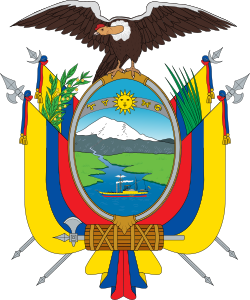 | |
| Armiger | Republic of Ecuador |
| Adopted | 31 October 1900 |
The coat of arms of Ecuador (Spanish: Escudo de armas del Ecuador) in its current form was established in 1900 based on an older version of 1845.
| Coat of arms of Ecuador | |
|---|---|
 | |
| Armiger | Republic of Ecuador |
| Adopted | 31 October 1900 |
The coat of arms of Ecuador (Spanish: Escudo de armas del Ecuador) in its current form was established in 1900 based on an older version of 1845.
Ecuadorian law describes the arms as follows: [1]
The Arms of Ecuador shall be an oval shield containing inside, in the upper part the sun with the part of the Zodiac where one finds the signs corresponding to the memorable months of March, April, May and June; in the lower part, to the right shall be represented the historical mountain Chimborazo, wherefrom shall start a river, and where it appears most abundant shall be a steamship, having for a mast a caduceus, as a symbol of navigation and commerce. The shield shall rest on a bundle of consular beams, a symbol of the republican dignity. It shall be adorned on the outside with national flags and branches of palm and laurel, and surmounted by a condor with wings displayed.
In the background of the oval shield is the mountain Chimborazo, while the river originating from its base represents the Guayas. Chimborazo is also the highest mountain in Ecuador and is part of the Andes Range. The steamboat on the river is named Guayas as well. The ship was built in Guayaquil and was the first seaworthy steamship built in both Ecuador and in all of South America. It was first put into service on 9 October 1841. The ship has the features of a Caduceus representing trade and economy. This kind of mast has two wings surrounding a pole with two snakes encircling it. [2] On top a golden sun surrounded by the Zodiac astrological signs for Aries, Taurus, Gemini and Cancer representing the months March to July to symbolize the duration of the March Revolution of 1845 that ousted General Juan José Flores.
The condor on top of the shield stretches his wings to symbolize power, greatness and strength of Ecuador. The condor also represents the idea that it will always be ready to attack any enemy. The shield is flanked by four national flags. The laurel on the left represents the victories of the republic. [3] The palm leaf on the right side is a symbol of the martyrs of the fight for independence and liberty. The Fasces below the shield represents the republican dignity. The final design of the coat of arms was completed in 1900. [4]
In the 1989 specifications issued to the Ecuadorian Military, the coat of arms has only eight colors that are used on the flag. The eight colors are yellow, blue, red (all from the national flag), sky blue, green, grey, silver and gold. There is also a nine piece instruction on how to draw the coat of arms, followed by a full color drawing and a black and white drawing of the arms. No size specifications have been laid out for the coat of arms except for when it is used on the national flag. [5]
The shield was introduced after the victory of the liberal revolution of 1845, but then flanked by white-blue-white flags; which were then replaced in the reintroduction of the Tricolor flags. The coat of arms in its current form was approved by congress on October 31, 1900.
 |  |  |  |  |  |  |  |  |
| Colonial Ecuador period | Free Province of Guayaquil | Gran Colombia | Ecuador | Ecuador | Ecuador | Ecuador | Ecuador | Ecuador |
| 1534-1820 | 1820 | 1821–1830 | 1830–1835 | 1835–1843 | 1843–1845 | 1845–1860 | 1860–1900 | 1900–present |

The coat of arms of the Argentine Republic or Argentine shield was established in its current form in 1944 but has its origins in the seal of the General Constituent Assembly of 1813. It is supposed that it was chosen quickly because of the existence of a decree signed on February 22 sealed with the symbol. The first mention of it in a public document dates to March 12 of that same year, in which it is stated that the seal had to be used by the executive power, that is, the second triumvirate. On April 13 the National Assembly coined the new silver and gold coins, each with the seal of the assembly on the reverse, and on April 27 the coat of arms became a national emblem. Although the coat of arms is not currently shown on flags, the Buenos Aires-born military leader Manuel Belgrano ordered to paint it over the flag he gave to the city of San Salvador de Jujuy, and during the Argentine War of Independence most flags had the coat of arms.

The coat of arms of Bolivia has a central cartouche surrounded by Bolivian flags, cannons, laurel branches, and has an Andean condor on top.

The national flag of Ecuador, which consists of horizontal bands of yellow, blue and red, was first adopted by law in 1835 and later on 26 September 1860. The design of the current flag was finalized in 1900 with the addition of the coat of arms in the center of the flag. Before using the yellow, blue and red tricolor, Ecuador's former flag had three light blue stripes and two white stripes with three white stars for each province of the country.The design of the flag is very similar to those of Colombia and Venezuela, which are also former constituent territories of Gran Colombia. All three are based on a proposal by Venezuelan General Francisco de Miranda, which was adopted by Venezuela in 1811 and later Gran Colombia with some modifications. There is a variant of the flag that does not contain the coat of arms that is used by the merchant marine. This flag matches Colombia's in every aspect, but Colombia uses a different design when her merchant marine ships are at sail.

The flag of El Salvador features a horizontal triband of cobalt blue-white-cobalt blue, with the coat of arms centered and entirely contained within the central white stripe. This design of a triband of blue-white-blue is commonly used among Central American countries. El Salvador's flag is one of few that currently use the color purple, due to the rainbow in its coat of arms.

The flag of Peru was adopted by the government of Peru in 1825, and modified in 1950. According to the article 49 of the Constitution of Peru, it is a vertical triband with red outer bands and a single white middle band. Depending on its use, it may be defaced with different emblems, and has different names. Flag day in Peru is celebrated on 7 June, the anniversary of the Battle of Arica.

The coat of arms of Chile dates from 1834 and was designed by the English artist Charles Wood Taylor (1792–1856). It is made up by a figurative background divided in two equal parts: the top one is blue and the bottom, red. A five pointed white star is in the centre of the shield. This background is supported in one side by a condor, the most significant bird of prey from the Andes, and in the other, by a huemul, a mammal endemic to Chile. Both animals wear golden naval crowns symbolising the heroic deeds of the Chilean Navy in the Pacific Ocean.
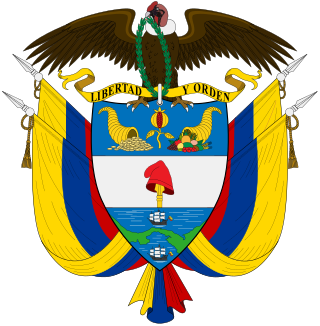
The coat of arms of Colombia contains a shield with numerous symbols. Perched on top of the shield is an Andean condor holding an olive crown and the condor symbolizing freedom. The national motto, Libertad y Orden, is on a scroll in between the bird and the shield in black font over golden background. The condor is depicted as displayed and looking to the right.

The coat of arms of Puerto Rico was first granted by the Spanish Crown on November 8, 1511, making it the oldest heraldic achievement still currently in use in the Americas. The territory was ceded by Spain to the United States in accordance to the peace treaty that ended the Spanish–American War in 1899, after which two interim arms were adopted briefly. A law was passed in 1905 that reestablished the historical armorial bearings as the arms of the territory. Then in 1976, after numerous investigations and amendments, the current version was adopted.

The coat of arms of Uruguay or Uruguayan shield was first adopted by law on March 19, 1829, and later on had some minor modification in 1906 and 1908. It was supposedly designed by Juan Manuel Besnes Irigoyen (1788–1865).
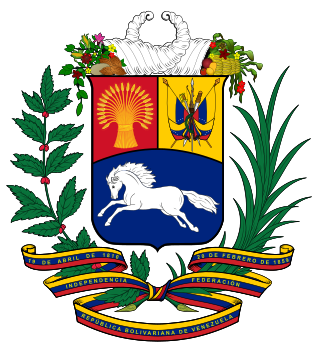
The current coat of arms of Venezuela was primarily approved by the Congress on April 18, 1836, undergoing small modifications through history, reaching the present version.
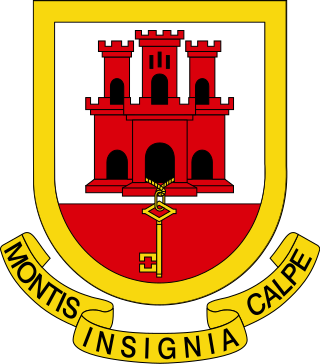
The coat of arms of Gibraltar was first granted by a Royal Warrant passed in Toledo on 10 July 1502 by Isabella I of Castile during Gibraltar's Spanish period. The arms consists of an escutcheon and features a three-towered red castle under which hangs a golden key.
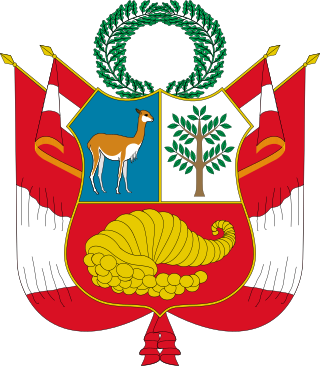
The Coat of arms of Peru is the national symbolic emblem of Peru. Four variants are used: the Coat of arms per se ; the National Coat of arms, or National Shield ; the Great Seal of the State ; and the Naval Coat of arms.

The coat of arms of the Department of Bolívar is the official coat of arms of the Department of Bolívar. The coat of arms had been in used before 1856, but in that year the Sovereign State of Bolívar was created, and its symbols changed; the new coat of arms, would be the same as the coat of arms of Colombia but with a red oval around it, that read “ESTADO SOBERANO DE BOLIVAR”. In 1886 the states were suppressed and departments created instead, the symbols were used once again but the originals were corrupted and so there are some variations on the current coat of arms, and that which was specified on the blazon.
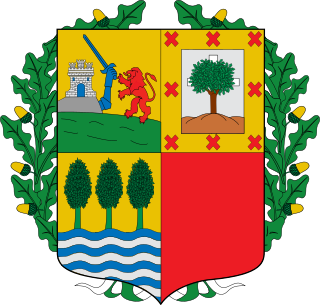
The current Basque coat of arms is the official coat of arms of the Basque Country, Autonomous community of Spain. It consists of a party per cross representing the three historical territories of Álava, Gipuzkoa and Biscay, as well as a fourth, void quarter. The arms are ringed by a regal wreath of oak leaves, symbolic of the Gernikako Arbola. The fourth quarter constituted since the late 19th century the linked chains of Navarre; however, following a legal suit by the Navarre Government claiming that the usage of the arms of a region on the flag of another was illegal, the Constitutional Court of Spain ordered the removal of the chains of Navarre in a judgement of 1986.

Guayas is a sail training ship of the Ecuadorian Navy. Launched in 1976, it was named in jointly in honor of Chief Guayas, the Guayas river, and Guayas, the first steamship that was constructed in South America in 1841, and is displayed on the Ecuadorian coat of arms. The ship's home base is Guayaquil, Ecuador.

The current coat of arms of Guatemala was adopted after the 1871 Liberal Revolution by a decree of president Miguel García Granados. It consists of multiple symbols representing liberty and sovereignty on a bleu celeste shield. According to government specifications, the coat of arms should be depicted without the shield only when on the flag, but the version lacking the shield is often used counter to these regulations.

The Coat of arms of Lima was granted by the Spanish Crown on December 7, 1537, by Royal Decree signed in Valladolid by Emperor Charles V and his mother Queen Joanna, endowing the city with the shield. In the Cédula, preserved for a time in the Archives of the Cabildo, and later known by its transcription in another file of the city, the shield is described as follows:
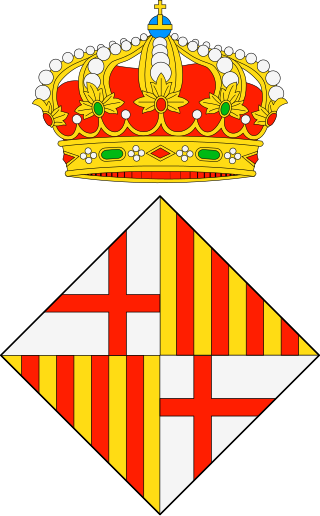
The coat of arms of Barcelona is the official emblem of the City Council of Barcelona, the capital of Catalonia, has its origin in the Middle Ages, these arms were first documented in 1329. The Government of Catalonia conferred the coat of arms and the flag as official symbols of the municipality in 2004. It has an escutcheon in lozenge which is commonly used in municipal coats of arms of cities in Catalonia. Currently the City Council of Barcelona also uses an isotype based on the heraldry of the city.
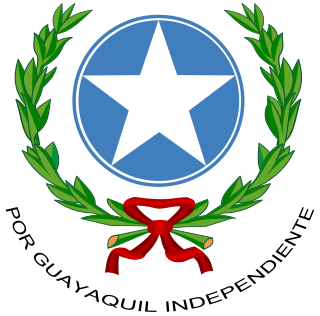
The coat of arms of Guayaquil is used for the Ecuadorian city of Guayaquil. Adopted in 1920, it's composed of a circle in blue with an inscribed silver star. The circumference is surrounded on both sides by two olive branches in the shape of a crown, linked at the bottom by a ribbon of gules. Under the ribbon is the slogan "Por Guayaquil independiente". It usually appears with an oval border in blue, although this is not an official version.

The coat of arms of Gran Colombia was adopted in 1821.